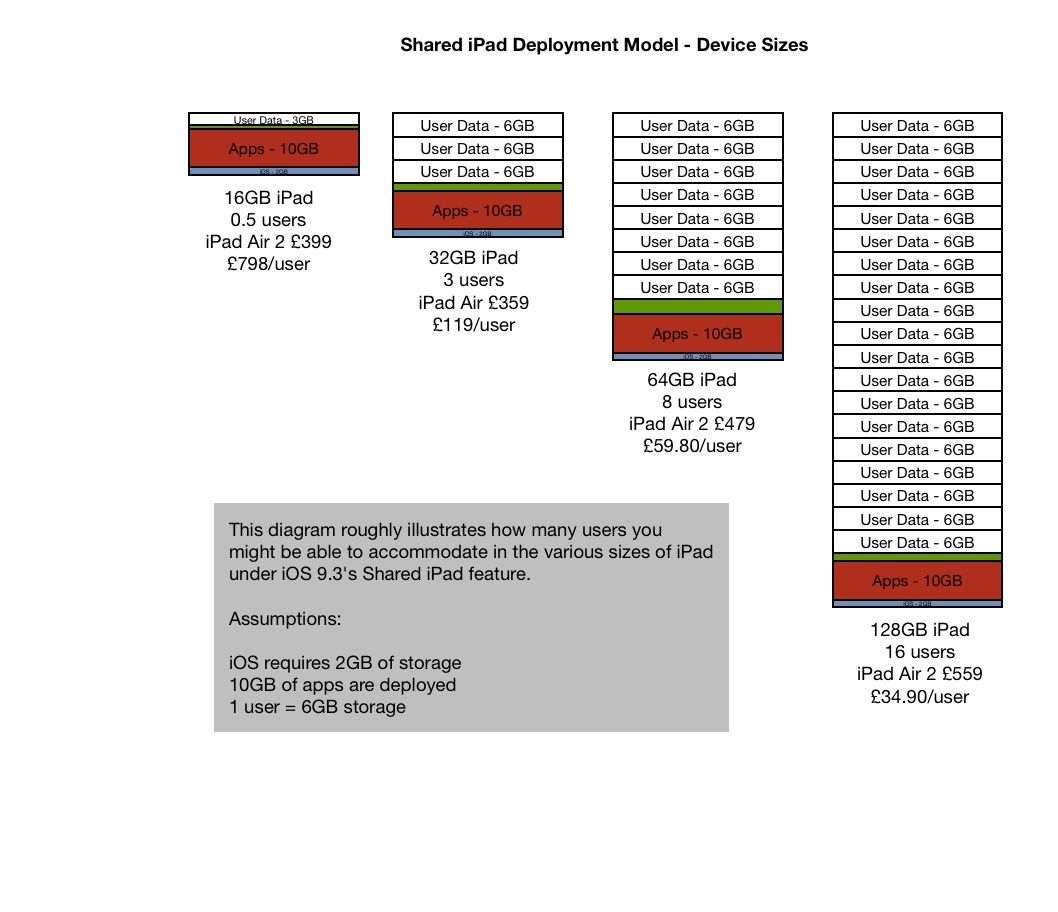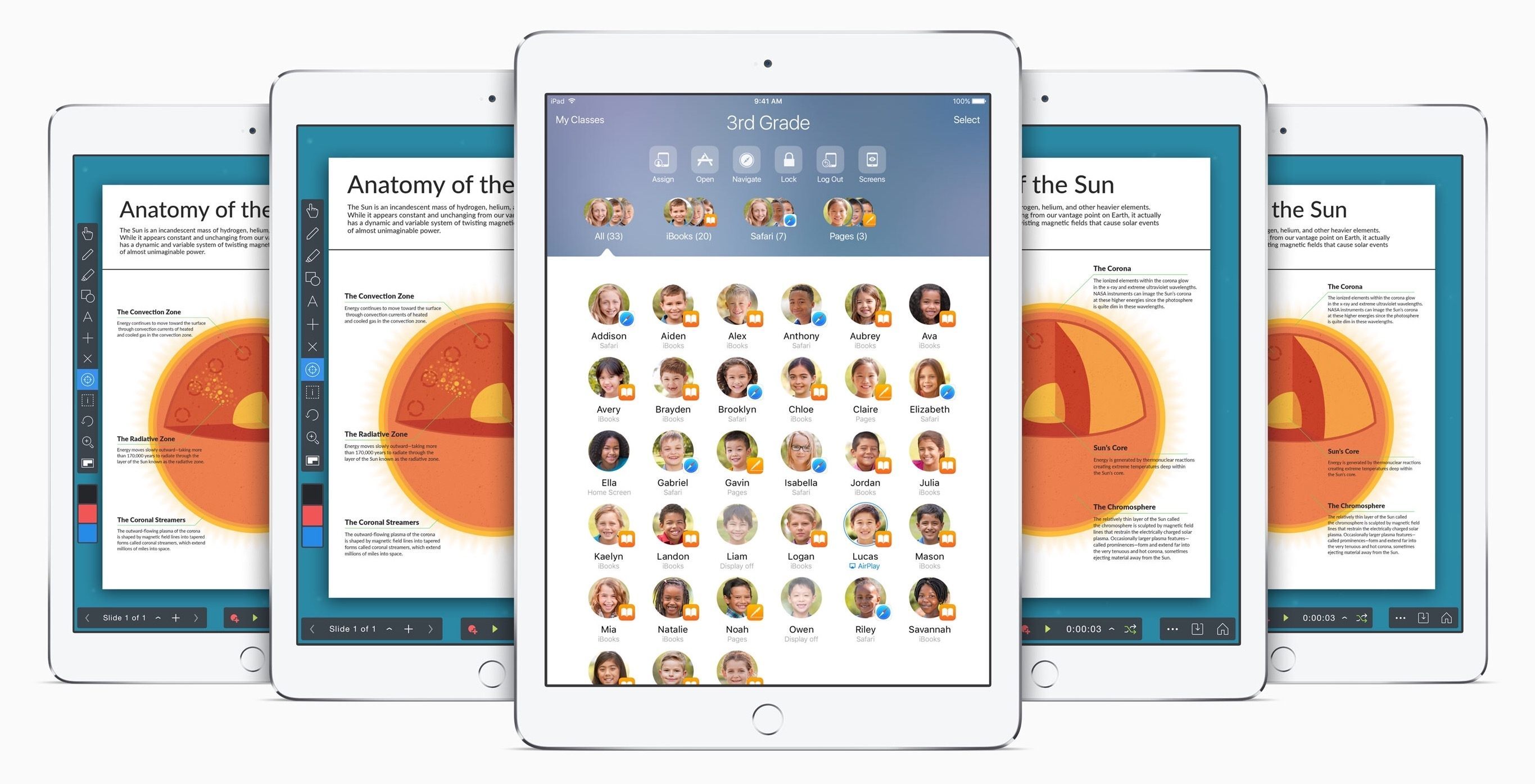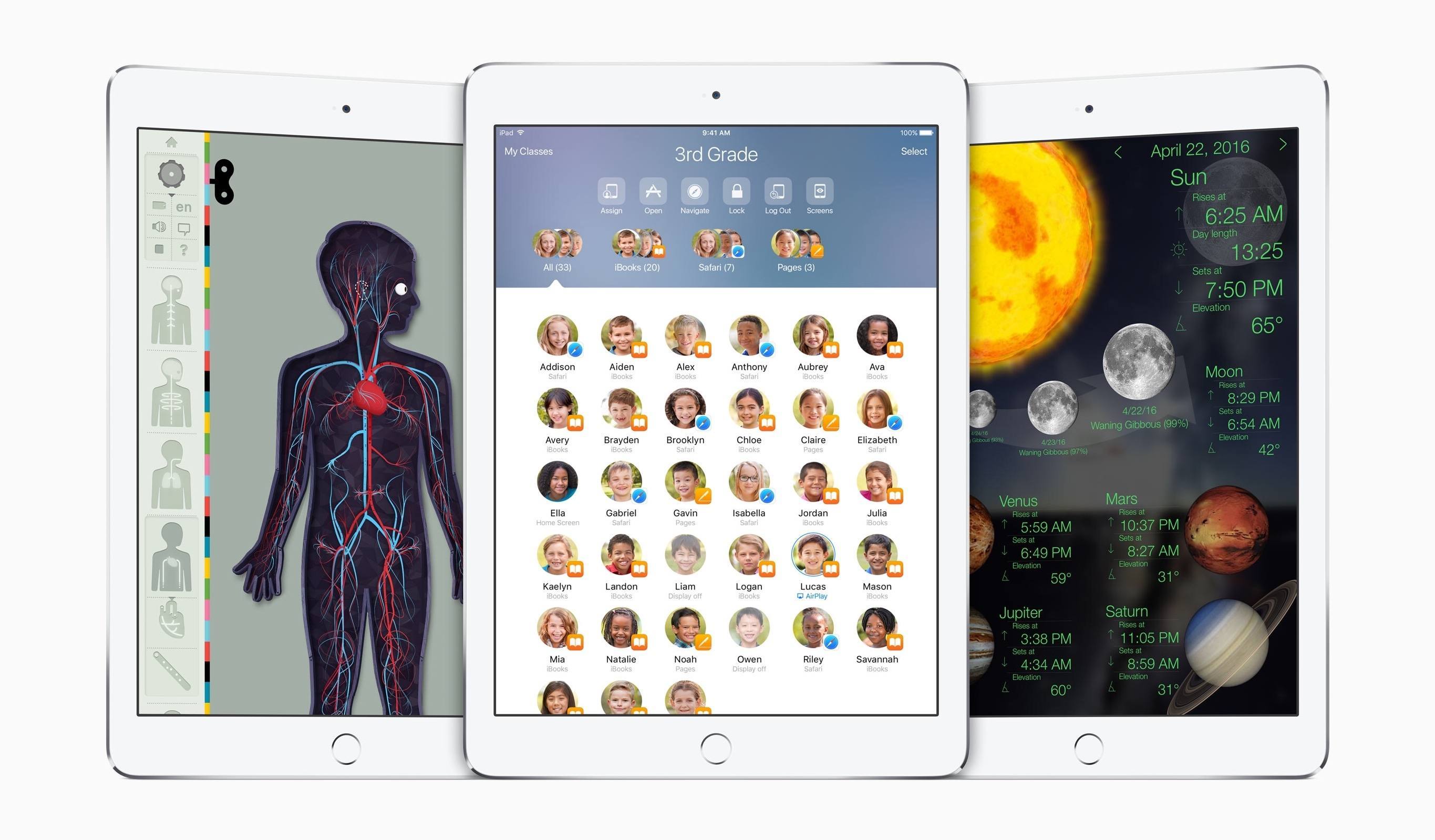The off-cycle release of major new features in iOS 9.3 is quite a departure for Apple. The usual cycle until now has been for major releases to debut at WWDC in the summer and ship in September/October. For the education market, however, this schedule has been extremely difficult to deal with. School usually starts in August or September - in the northern hemisphere at least - and having a major platform upgrade happen right after school starts is hard to cope with.
That has all been turned on its head. On January 11th, Apple announced the developer beta release of iOS 9.3. Unusually for a developer beta, Apple also produced the kind of iOS preview webpages that are normally seen in the time between the WWDC announcement of a new major iOS version and its eventual release.
Two things are happening with iOS 9.3. Firstly, it brings important user-facing features, such as Night Shift, in a point release. Secondly, it brings a beta of major features for education. It is important to remember that the education features will still be in beta after 9.3 is released. I was informed by Apple that the long lead-time is intended to give schools time to thoroughly test and provide feedback on these features before the start of the 2016-17 school year in August/September.
You might ask why these features are coming now and not waiting for iOS 10 later in the year. I think the simple answer is that Chromebooks are finally presenting a serious threat to Apple in the US education market. Schools start looking at their August deployment plans in January and if you are Apple, it’s important that these schools don’t decide to adopt Chromebooks.
Chromebooks, while definitely more limited in their range of uses, have three significant advantages for schools: they’re cheaper, easier to share, and easier to deploy than iOS devices.
While Apple isn’t cutting the price of iPads for schools, there are four major new features and programmes coming in iOS 9.3 that will make iPads easier to share and easier to deploy. iOS administrators everywhere should be directing their gifts of beer and muffin baskets to the Chromebook education team at Google this time around.
Shared iPad
The first and most significant feature of iOS 9.3 for education is the Shared iPad feature. This is one of the features that is being specifically described as “for education”, so it won’t be available for general iOS users just yet.
Shared iPad brings multi-user support to iOS for the first time. This is genuine Unix-level user separation of almost all configuration and data. Some settings that can be configured are set at the device level, such as the WiFi password.
The high-level goal of Shared iPad is to allow multiple students to log into an iPad with their Apple ID and to have their apps and content ready and waiting for them.
How is this achieved? To first order, it works the same as support for multiple users does on OS X. Users have data on the local device storage, they log in and the computer appears to show their data alone.
Of course, this is much easier to achieve when the computer has 500 GB or more of local storage attached. Even the largest iOS devices have barely more than a fifth of that, and schools are not usually buying 128 GB iPads.
To compensate, Shared iPad is able to eject users’ data from the local storage, save it in the cloud, and restore it on-demand. OS X Server’s Caching Server feature has a role to play here in accelerating the restore, but the ultimate backing storage is iCloud.
The question of whose cloud and whose data quotas remains unclear. The more I think about it, the less Shared iPad makes sense to me unless Apple is going to provision students’ Apple IDs with much higher storage quotas than they have right now. If a student creates 15 GB of data on their shared 32 GB iPad and then a student who has 20 GB of data wants to sign in, where does that first 15 GB go when the student only has 5 GB of iCloud storage?
Schools wanting to share a set of iPads between students will need to spend some time thinking about how large an iPad they need to buy. Using a rough average from my school of 6 GB of data per user and 12 GB used up for apps and iOS itself, a 32 GB iPad could accommodate the data of three users on local storage. A 64 GB iPad could accommodate eight users and a 128 GB iPad could accommodate 16 users without having to purge and restore data.
With the best will in the world, networks are not as fast as local storage – a rule that goes double for most school networks – so it will be an important job to size iPads correctly to achieve best performance for the number of expected users. If Apple isn’t going to sell one iPad for each student, they might at least start selling many more 128 GB iPads into education. 16 GB iPads are going to be a terrible experience under Shared iPad.
One big question here is whether and how schools can ensure that pupils have enough iCloud storage to allow their entire data set to be purged and restored.
Apple Classroom
The second tentpole in the iOS 9.3 announcement is an app called Apple Classroom. This app is intended to be a “teacher’s assistant” when using iOS in the classroom.
Classroom will be distributed through the App Store, rather than as a built-in app on iOS. It supports all the iOS 9 multitasking features so that a teacher can work on one app and have Classroom as the secondary app. Classroom does not have an iPhone version.
You might wonder how Classroom knows that the person using the iPad is a teacher. The answer is that as downloaded, the Classroom app can do nothing. It first has to be sent configuration data through a school’s Mobile Device Management (MDM) system. This is similar to how apps written by MDM vendors typically interact with those servers.
Classroom brings together a number of long-desired features for iOS classrooms.
The first major new feature is Screen View. This is a future whereby a teacher can remotely view the screen of a pupil’s iPad. Screen View works in a similar way to Apple TV’s AirPlay in that it uses Bluetooth and WiFi Direct to discover nearby iPads and the school’s existing WiFi infrastructure to send the data once the connection is established. As a result, Classroom is suitable for in-room help and monitoring but is not equivalent to, say, delivering remote support by screen-sharing via Skype. Screen View is also observe-only. It is not possible for the teacher to send touch commands to the remote iOS device.
The philosophy of Classroom is to be a “teacher’s helper”. In Classroom you can see an overview of the screens of all pupils in the class and focus in on one. You can also see which apps pupils are using and automatically launch resources on the class iPads. An example of this might be launching a URL on all the iPads at the same time. Other workflows are possible, including a share sheet action whereby a teacher can send a URL directly from their Safari share sheet to the entire class via Classroom.
The next feature is called Remote Control. This is a capability that has been available through MDM servers for some time, but which has always been a little too slow and unreliable for fast classroom use. Remote Control allows a teacher to launch apps, websites, or books on every iPad in the class simultaneously.
An additional capability is to lock students into a specific app for a period. This is similar to the features available in Guided Access but activated remotely. I’m not sure it will be too useful in high school, where students need access to multiple apps to work, but it will be of great benefit in early years education.
Two other capabilities are the ability for a teacher to start an AirPlay session from a student’s iPad to an Apple TV and to reset a student’s forgotten password.
Managed Apple ID
One of the agonies of managing iOS in recent years has been the need to have Apple IDs for each device if you wanted to distribute apps over-the-air to students.
This was introduced around iOS 7 when the Volume Purchase Programme gained the so-called “Managed Distribution” feature. This meant that admins could assign apps to students and revoke them when they were no longer needed. This was a huge advance from previous deployment techniques, but the model was “assign this app to this Apple ID” - which meant having an Apple ID in the first place.
This was difficult for several reasons. There was no way to automate creating all these Apple IDs, beyond using something like Keyboard Maestro to control iTunes with puppet strings. Even if you did manage to get a workable solution in place, you would usually get your IP address banned by the iTunes Store if you made too many Apple IDs in a short period.
iOS 9 walked this back a bit by introducing Device Assignment. This allows admins to assign an app to a device rather than an Apple ID. However, this didn’t solve schools’ problems because students still needed an Apple ID for things like signing into iTunes U courses. One step forward, one step back.
Finally, Apple is solving this for good by introducing Managed Apple IDs through a portal named Apple School Manager. A Managed Apple ID is an Apple ID that is created for a student by a school admin and is limited in various ways. From my reading it would seem that a Managed Apple ID is able to do “all the things that Apple doesn’t legally need a parent’s consent to let a student do”.
A Managed Apple ID will be strictly limited in certain ways. For example, a student using a Managed Apple ID will be able to browse but not buy from Apple’s App Store and iTunes Store. This has implications for a school’s app deployment model: schools using Managed Apple ID will have to push out every app that students want. This is fine for schools where the iPad is strictly designed to be for ‘school work’. Other schools, such as my own, take a more holistic approach to iPad deployment and let students of a certain age install their own apps. If we were to move to Managed Apple ID, we would probably have to design a process whereby students could request apps – and we would have to be flexible in what we allow to be installed.
Managed Apple IDs are very interesting for another reason: they are Apple IDs that are guaranteed to be owned by people working in education. Until now, all Apple IDs have been created equal. Whether created (manually) by a school admin or brought from home by a student, an Apple ID was an Apple ID.
Although there has been no announcement yet, the possibility of Apple providing education-only special treatment to these Apple IDs seems like something that could happen in the future. Indeed, it needs to happen. One of the great benefits of using Google Apps for Education is that every educational Google account gets unlimited storage on Google Drive. Apple desperately needs to catch up here. 5 GB free iCloud storage is a drop in the bucket. If Managed Apple IDs were given unlimited iCloud storage, programs like Shared iPad would be a lot easier to understand and manage.
Why Now?
Many people have wondered why Apple would preview major new features in January and in a point release of iOS. The simple answer is: to stop Chromebooks.
iOS 9.3 is previewing in January because January is when schools start to decide what they’re going to do with technology in July, August, and September. It’s important that Apple has a way to stay in the running in all those schools and districts that are contemplating a change away from Windows for 2016-17.
Google’s Chromebooks have been finding increasing favour in schools, particularly in the United States. There are three main reasons for this: Chromebooks are cheaper, they’re vastly easier to share between students, and they are trivially easy to deploy.
If a school or district has determined that buying one device for each pupil isn’t going to happen, Chromebook becomes the default choice and iPad is basically out of the game, even before the relative merits of each as a teaching tool have been discussed.
This represents a significant risk for Apple. Platform shifts in education are rare. The current transition from Windows to either iOS or ChromeOS is really the first since schools transitioned from Apple II (in the US) or the BBC Micro (in the UK) over 25 years ago. Who knows when the next one will happen? That’s why it’s so important for Apple to stay in the game.
iOS 9.3 goes a long way to solving the problem of sharing iPads between students and easing the administration burden. We can hope that Apple will take similarly bold steps to cut the cost of going 1-to-1 in the next round of iPad updates.





